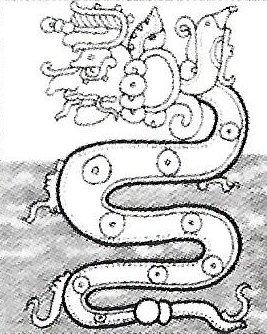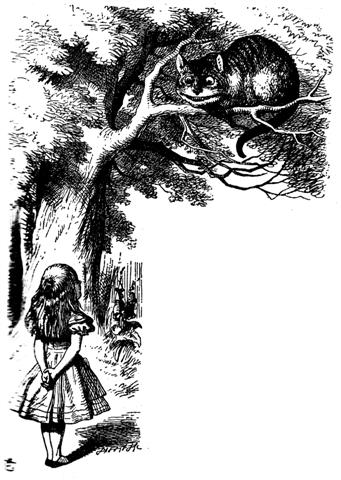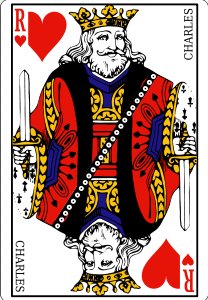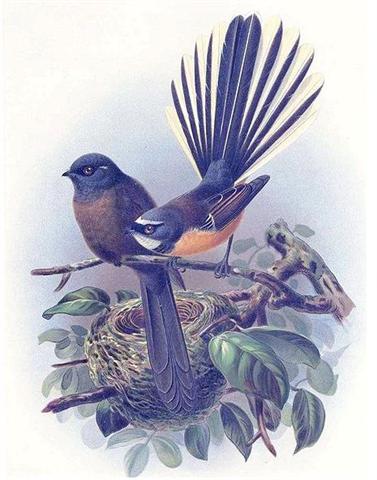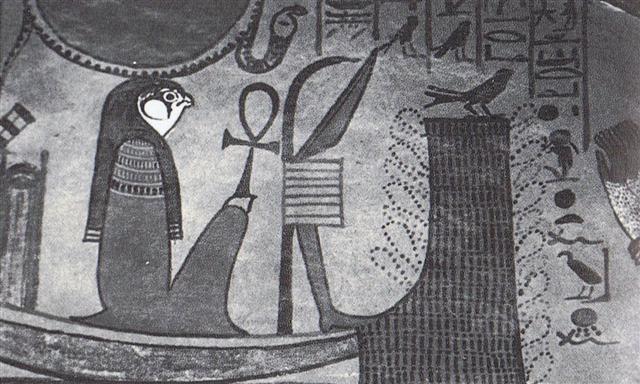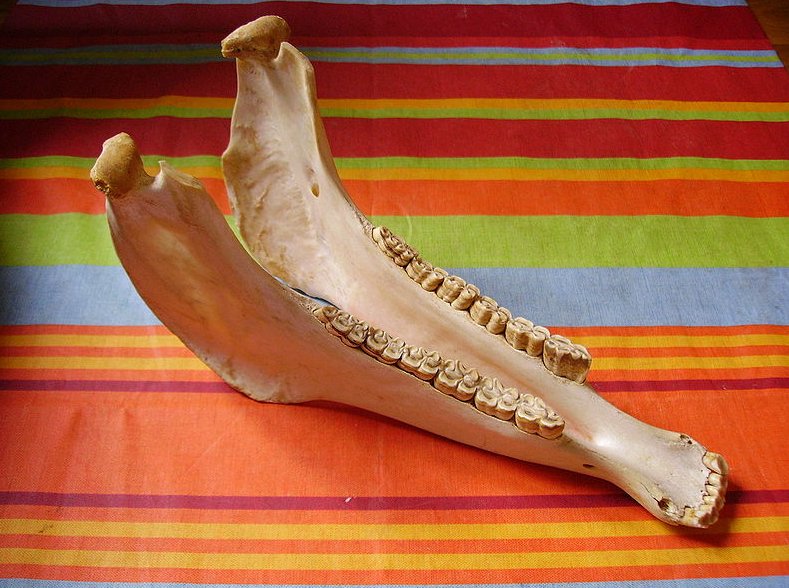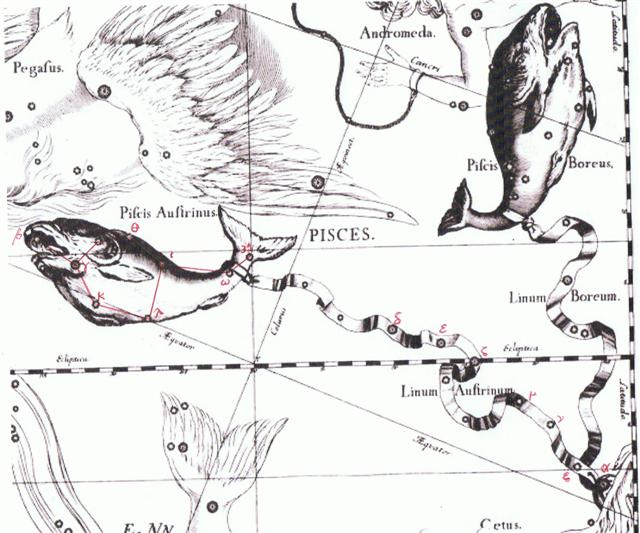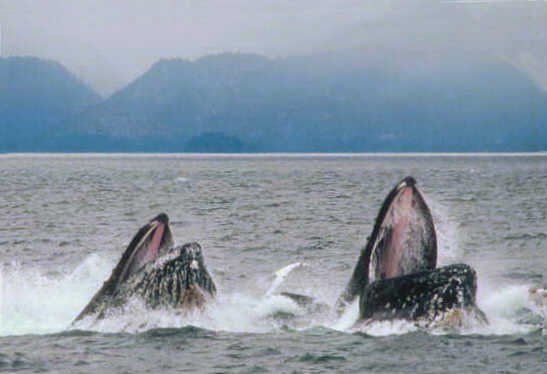Among all the possible threads of allusion we should pick out one which will enable us to move on as regards the fish-hook and the Egyptian X: ... If my suggestion be admitted that the Babylonians dealt not with the daily fight but the yearly fight between light and darkness - that is, the antithesis between day and night was expanded into the antithesis between the summer and the winter halves of the year - then it is clear that at the vernal equinox Scorpio setting in the west would be watching the sunrise; at the autumnal equinox rising in the east, it would be watching the sunset; one part would be visible in the sky, the other would be below the horizon in the celestial waters. If this be so, all obscurity disappears, and we have merely a very beautiful statement of a fact, from which we learn that the time to which the fact applied was about 3000 B.C., if the sun were then near the Pleiades ... In the H text we can see a change from above to below associated with the Egyptian X - here located at my inferred (*) glyph position 6-28 (→ 2 * 3.14 = Full Cycle, Haka-taka): ... There is a couple residing in one place named Kui [Tui] and Fakataka [Haka-taka]. Tui. 1. To sew mats, to make strings. E-tahi tuitui reipá i Te Pei, ekó rava'a e-varu kaukau; i-garo ai i Hiva, i te kaiga, a necklace of mother-of-pearl is on te Pei, few will find it (lit: eight groups of people); it has remained in Hiva, in our homeland. 2. The three stars of Orion's Belt. Vanaga. Taka, takataka. Circle; to form circles, to gather, to get together (of people). Vanaga. 1. A dredge. P Mgv.: akataka, to fish all day or all night with the line, to throw the fishing line here and there. This can only apply to some sort of net used in fishing. We find in Samoa ta'ā a small fishing line, Tonga taka the short line attached to fish hooks, Futuna taka-taka a fishing party of women in the reef pools (net), Maori takā the thread by which the fishhook is fastened to the line, Hawaii kaa in the same sense, Marquesas takako a badly spun thread, Mangareva takara a thread for fastening the bait on the hook. 2. Ruddy. 3. Wheel, arch; takataka, ball, spherical, round, circle, oval, to roll in a circle, wheel, circular piece of wood, around; miro takataka, bush; haga takataka, to disjoin; hakatakataka, to round, to concentrate. P Pau.: fakatakataka, to whirl around. Mq.: taka, to gird. Ta.: taa, circular piece which connects the frame of a house. Churchill. Takai, a curl, to tie; takaikai, to lace up; takaitakai, to coil. P Pau.: takai, a ball, to tie. Mgv.: takai, a circle, ring, hoop, to go around a thing. Mq.: takai, to voyage around. Ta.: taai, to make into a ball, to attach. Churchill. After the couple stay together for a while Fakataka is pregnant. So they go away because they wish to go to another place - they go. The canoe goes and goes, the wind roars, the sea churns, the canoe sinks.
Kui expires while Fakataka swims. Fakataka swims and swims, reaching another land. She goes there and stays on the upraised reef in the freshwater pools on the reef, and there delivers her child, a boy child. She gives him the name Taetagaloa [Tae-tagaroa = Not-Tangaroa → Tane]. ... Then three lines are drawn east and west, one across the northern section indicates the northern limit of the Sun (corresponding with the Tropic of Cancer) about the 15th and 16th days of the month Kaulua (i.e., the 21st or 22nd of June) and is called ke alanui polohiwa a Kane, the black-shining road of Kane. The line across the southern section indicates the southern limit of the Sun about the 15th or 16th days of the month Hilinama (December 22) and is called ke alanui polohiwa a Kanaloa, the black-shining road of Kanaloa. The line exactly around the middle of the sphere is called ke alanui a ke ku'uku'u, the road of the spider, and also ke alanui i ka Piko a Wakea, the way to the navel of Wakea (the Sky-father). Between these lines are the fixed stars of the various lands, na hokupaa a ka aina. (These are the stars which hang suspended in the zeniths of the Polynesian islands most of which lie within the tropics.) On the sides are the stars by which one navigates ... When the baby is born a golden plover [rain bird] flies over and alights upon the reef. (Kua fanau lā te pepe kae lele mai te tuli oi tū mai i te papa).
And so the woman thus names various parts of the child beginning with the name 'the plover' (tuli): neck (tuliulu), elbow (tulilima), knee (tulivae) ...
The text in line Ha6 (as in all other lines with even numbers) will be perceived upside down - as if reflected on the calm surface of a lake - by a reader beginning at the bottom with line a1 - where the glyphs are 'standing on their feet'.
Counting from the tail of Imix (see above) - the 1st Mayan day sign meaning Sea-dragon, Water, Wine - we can see that the 7th Sun symbol has been raised up. In line Ha7 the glyphs are standing on their feet and the 1st glyph in this line is a bottle gourd (hipu):
Hipu. Calabash, shell, cup, jug, goblet, pot, plate, vase, bowl, any such receptacle; hipu hiva, melon, bottle; hipu takatore, vessel; hipu unuvai, drinking glass. P Mgv.: ipu, calabash, gourd for carrying liquids. Mq.: ipu, all sorts of small vases, shell, bowl, receptacle, coconut shell. Ta.: ipu, calabash, cup, receptacle. Churchill. ... Then the big Fish did swallow him, and he had done acts worthy of blame. Had it not been that he (repented and) glorified Allah, He would certainly have remained inside the Fish till the Day of Resurrection. - Qur'an, chapter 37 (As-Saaffat), verse 139–144. But We cast him forth on the naked shore in a state of sickness, And We caused to grow, over him, a spreading plant of the gourd kind. And We sent him (on a mission) to a hundred thousand (men) or more. And they believed; so We permitted them to enjoy (their life) for a while. - Qur'an, chapter 37 (As-Saaffat), verse 145–148 ... ... The state of the tree loomed large in their thoughts, because it came about at the same time the head of One Hunaphu was put in the fork. The Xibalbans said among themselves: 'No one is to pick the fruit, nor is anyone to go beneath the tree', they said. They restricted themselves, all of Xibalba held back. It isn't clear which is the head of One Hunaphu; now it's exactly the same as the fruit of the tree. Calabash came to be its name, and much was said about it. A maiden heard about it, and here we shall tell of her arrival ...
But I have ignored this complication when copying the rongorongo texts in order to save time and effort.
There are 12 lines of text on side a of the H tablet and another 12 on its side b. By counting half (12 + 12) = 6 + 6 we could expect the text to cover a pair of half-years, each with 6 months. These half-years would, though, hardly stretch for 180 days, because my estimate for the total number of glyph positions on the H tablet suggests such a year measure could be half (648 + 648) = 648 = 324 + 324 = 6 * 108 = 12 * 54 = 24 * 27 = 3 * 8 * 3 * 9 = 3 * 216 (= 3 * 360 / 5) = 18 * 36 = 12 * 36 + 6 * 36 = 432 + 216 = 540 + 108 = ½ (1080 + 216). And so on. ... It is known that in the final battle of the gods, the massed legions on the side of 'order' are the dead warriors, the 'Einherier' who once fell in combat on earth and who have been transferred by the Valkyries to reside with Odin in Valhalla - a theme much rehearsed in heroic poetry. On the last day, they issue forth to battle in martial array. Says Grimnismal (23): 'Five hundred gates and forty more - are in the mighty building of Walhalla - eight hundred 'Einherier' come out of each one gate - on the time they go out on defence against the Wolf.'
That makes 432,000 in all, a number of significance from of old. This number must have had a very ancient meaning, for it is also the number of syllables in the Rigveda. But it goes back to the basic figure 10,800, the number of stanzas in the Rigveda (40 syllables to a stanza) [40 * 270 = 10800] which, together with 108, occurs insistently in Indian tradition, 10,800 is also the number which has been given by Heraclitus for the duration of the Aiōn, according to Censorinus (De die natali, 18), whereas Berossos made the Babylonian Great Year to last 432,000 years. Again, 10,800 is the number of bricks of the Indian fire-altar (Agnicayana). 'To quibble away such a coincidence', remarks Schröder, 'or to ascribe it to chance, is in my opinion to drive skepticism beyond its limits.' ...
There was a 'fish-hook' incised at a place 9 right ascension days before the Sun star in Ha6-15:
Hetu 1. To (make) sound; figuratively: famous, renowned. 2. To crumble into embers (of a bonfire). Hetu'u. Star, planet; hetu'u popohaga morning star; hetu'u ahiahi evening star; hetu'u viri meteorite. Vanaga Hetu 1. Star (heetuu); hetu rere, meteor; hetu pupura, planet. P Pau.: hetu, star. Mgv.: etu, id. Mq.: fetu, hetu, id. Ta.: fetu, fetia, id. The alternative form fetia in Tahiti, now the only one in common use, need not be regarded as an anomaly in mutation. It seems to derive from Paumotu fetika, a planet. Its introduction into Tahiti is due to the fashion of accepting Paumotu vocables which arose when the house of Pomare came into power. 2. Capital letter (? he tu). 3. To amuse. 4. To stamp the feet. Hetuhetu, to calk, to strike the water. Hetuke, sea urchin. Churchill. ... 'The sun's rays,' he went on, 'are fire and the Nummo's excrement. It is the rays which give the sun its strength. It is the Nummo who gives life to this star, for the sun is in some sort a star.' It was difficult to get him to explain what he meant by this obscure statement. The Nazarene made more than one fruitless effort to understand this part of the cosmogony; he could not discover any chink or crack through which to apprehend its meaning ...
Did this hook fail to lift up the land-fish?
No, there was only an interruption: ... The fish came near the surface then, so that Maui's line was slack for a moment, and he shouted to it not to get tangled. But then the fish plunged down again, all the way to the bottom. And Maui had to strain, and haul away again. And at the height of all this excitement his belt worked loose, and his maro fell off and he had to kick it from his feet. He had to do the rest with nothing on ... In the midst (at the apex) of the struggle his loincloth fell off - he became nude as a newborn baby. Supposing the loincloth (maro) referred to the month named Maro (= June), it would suggest *Ha6-29 might have corresponded to the last day of June - i.e. day zero of the new cycle beyond 6-28 = 2 * 314. The dark night of the Moon was that of Hiro (Mercury).
However, in the H text the fish struggle could have begun at the fish-hook in Ha6-6 (→ 6 * 6 = 36 → 360) and stretched for 32 days (→ Dramasa, the south pole star at *320). For 27 + 5 = 32 and 360 + 32 = 392, as in the glyph number at the north pole star Polaris, evidently at the last glyph on the front side of the C tablet.
Furthermore, from Dramasa (*320) to Polaris (*392 = *26 + *366) there were *72 right ascension days. 392 - 72 = 320 = 137 + 183. The word dzaneb might be equivalent to deneb (tail), because the star named Dzaneb was ω Pisces:
June 6 (157 = 314 / 2) + 31 = 188 (July 7) = 288 (October 15) - 100 = *108.
|
||||||||||||||||||||||||||||||||||||||||||||||||||||||||||||||||||||||||||||||||||||||||||||||||||||||||||||||||||||||||||||||||||||||||||||||||||||||||||||||||||||||||||||||||||||||||||||||||||||||||||||||||||||||||||||||||||||||||||||||||||||||||||||||||||||||||||||||||||||||||||||||||||||||||||||||||||||||||||||||||||||||||||||||||||||||
.jpg)


